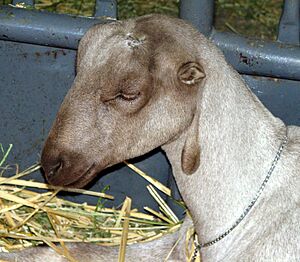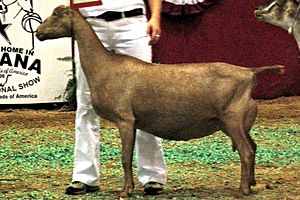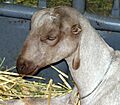American Lamancha facts for kids

The American Lamancha goat, often just called Lamancha, is a special type of dairy goat. It was first bred in the United States around 1927 by Mrs. Eula Fay Frey. These goats are known for their unique, very short ears.
Lamancha goats are easy to spot because of their tiny ears. They are also famous for producing a lot of milk. Their milk has a good amount of butterfat, which makes it rich. People also love Lamanchas for their friendly personalities.
This breed was officially recognized in the early 1950s. On January 27, 1958, they were formally registered as "Lamancha or American Lamancha" goats. The Lamancha is the only dairy goat breed created in the United States. While some old stories mention short-eared goats from Spain, there has never been a specific "Spanish LaMancha" breed. The term "American Lamancha" means a goat that is mostly Lamancha. Today, many purebred American Lamanchas are registered.
Contents
What Colors Can Lamancha Goats Be?
Lamancha goats can come in any color or pattern. You might see them in solid colors, spotted, or with different markings.
Their Unique Ears: Gopher and Elf
The most famous feature of Lamancha goats is their ears. They are very short! The American Dairy Goat Association (ADGA) has specific rules for their ears:
- Gopher ear: This ear is super short, usually no more than 1 inch long. It might even seem like there's no ear at all. The tip of the ear must turn up or down. Only bucks (male goats) with gopher ears can be officially registered.
- Elf ear: This ear can be a bit longer, up to 2 inches. The tip also turns up or down. These ears have a little more cartilage, which gives them a small shape.
A Little Ear History
When the breed was first recognized, there were four types of acceptable ears. These included two "gopher" types (short and long) and two "elf" types (regular and "Cookie" ears). After 1960, only bucks with the shortest gopher ears could be registered.
Mrs. Frey's herd mostly had regular Lamancha and Cookie ears. But the rules changed in the early to mid-1980s. Since then, only the two main types, gopher and elf, are recognized.
Where Do Lamancha Goats Come From?
The exact history of the Lamancha goat is a bit of a mystery. But we know that short-eared goats have been around for a long time. Records from ancient Persia mention them.
Short-eared goats from La Mancha, Spain, were shown at the World's Fair in Paris in 1904. They were simply called "La Mancha, Cordoba, Spain." Some experts believe Lamanchas came from Spanish Murciana goats. These were imported to the U.S. from Mexico for milk and meat.
Other ideas suggest their ancestors might be Criollo goats. These goats were brought to South America from Spain in the 1500s. They were used for both meat and milk.
The Murciana Connection
The Murciana goat breed comes from the Murcia area in southeastern Spain. While their ears are shorter than many other goats, they are shaped more like Swiss breeds. These goats were in the U.S. by the 1920s.
Spanish Mission Goats
Spanish missionaries brought short-eared goats to California. These goats were good for both milk and meat. They were very similar to today's Lamancha goats. The missionaries sometimes called them "cuties" or "monkeys." These goats spread throughout the West from the missions. Many believe these are the ancestors of modern Lamancha goats.
Mrs. Frey's Breeding Journey
In the late 1800s, Mrs. Phoebe Wilhelm in California kept a herd of these short-eared goats. She bred them with purebred Toggenburg bucks. Later, she used Alpine and Nubian bucks. Even after many years of breeding short-eared does with long-eared bucks, the unique Lamancha ear trait stayed strong.
Serious breeding to create a true short-eared goat breed didn't start until the late 1930s. Mrs. Eula Fay Frey played a huge role. She bought Poplar Dairy in Bell, California in 1937. The dairy had 130 goats, including two short-eared ones: a small doe and her son, 'Tommy'. Mrs. Frey was amazed by how much milk the short-eared doe produced.
Mrs. Frey decided to keep a special short-eared doeling named 'Peggy'. Peggy was born from a cross between Tommy and another doe. Peggy became an amazing milker, producing nearly two gallons of milk a day! She was Mrs. Frey's favorite and could even do tricks.
Peggy and another goat named 'Nesta' became the main mothers of Mrs. Frey's herd. They are considered the ancestors of the entire Lamancha breed.
Mrs. Frey's goal was to create a goat that could produce a lot of tasty milk. She wanted goats with strong bodies, good udders, and short, smooth hair. They could be any color and have horns or not.
After the breed was recognized, these goats became known as American Lamanchas. Mrs. Frey worked with others to set up the official herd book for the breed. She continued to carefully breed her goats, always choosing the best ones. By 1957, she only bred American Lamanchas with other American Lamanchas.
In 1960, Mrs. Frey received the Mary L. Farley Award. This award recognized her many years of hard work in developing the American Lamancha breed. She passed away in 1968.
Achievements and Records
Lamancha goats have achieved many impressive records in milk production and show rings.
- In 1960, the first Lamancha does were listed for their high milk production. Five does from the Bomar herd showed excellent results.
- The first Lamancha goat was sold at a national sale in 1960 for $95.
- In 1961, a Lamancha doe named Fay's Spider L-85 set a new milk record. She produced over 3000 pounds of milk in one test! This record stood for twelve years.
- In 1962, Mrs. Frey's own buck, Fay's Anthony L-6, became the first Lamancha buck to be recognized as an Advanced Registry Herd Sire.
- Lamanchas first appeared at the National Dairy Goat Show in 1962. A doe named Midolane Little Francis L-198 became the first Lamancha National Champion. She was also the first goat of any breed to win a National Show twice in a row!
- In 1974, a Lamancha doe named Goat City Marzipan 2*M L-1049 set a new all-time milk record. She produced an amazing 4510 pounds of milk!
- In 1977, three Lamanchas were sold at the first-ever Colorama Sale. The sale itself was named after a Lamancha doe, Nixon's Miss Colorama L1086.
- A Lamancha doe named GCH Rocinante Kellie *M made history. She was the first doe of any breed to be named National Champion three times in a row (1980, 1981, and 1982)!
- In 1982, a Lamancha buck named B Longden Acres C. Lucky Bid A/I sold for $4,100, setting a new record for the Spotlight Sale.
See Also
Images for kids




